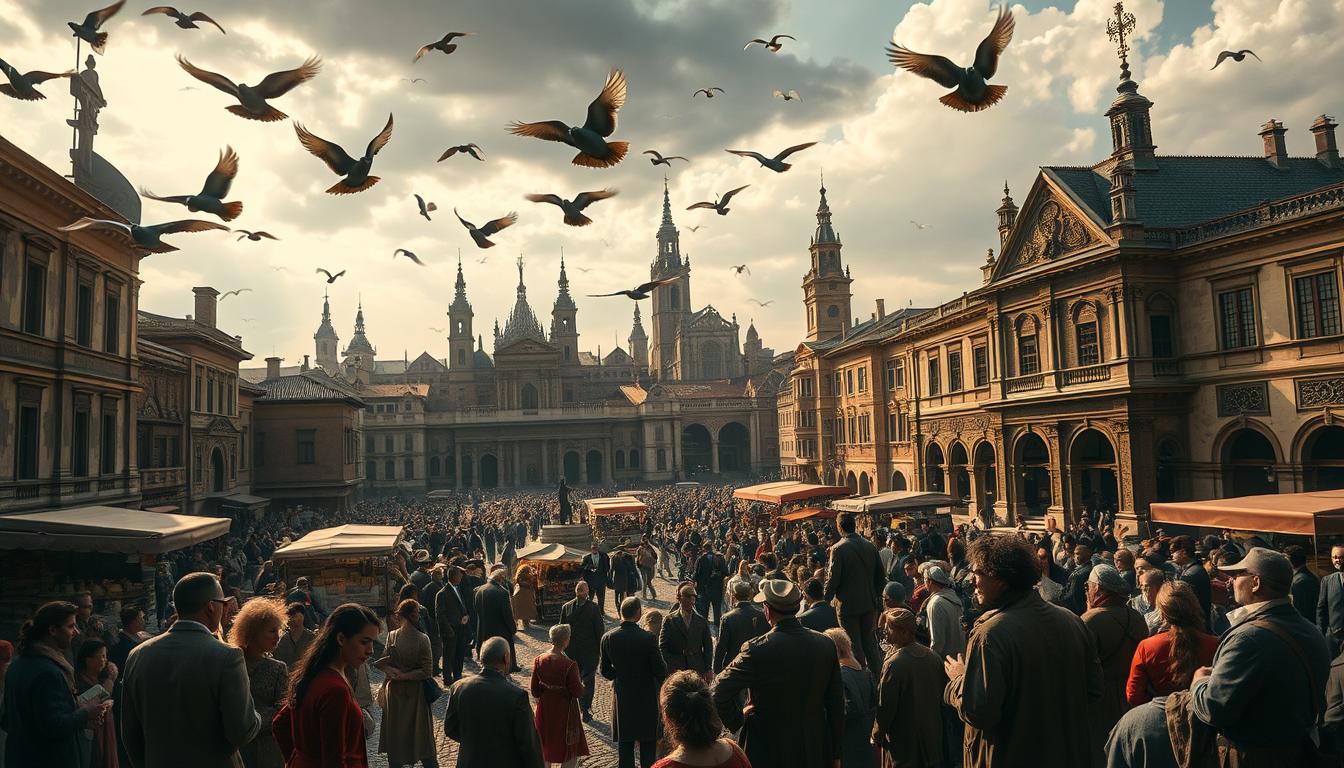Imagine a vibrant street in Venice circa the 1500s. A merchant, with hands shaking, carefully opens a letter. The wax seal cracks, revealing news from afar. This scene embodies the essence of news dissemination in the Renaissance, a period marked by significant advancements in communication.
In this era, news dissemination was a slow yet steady process. The Renaissance populace relied on a sophisticated network of communication. This network included personal letters, handwritten news sheets, and the emergence of printed materials. The art of disseminating news was complex, with information flowing through travelers, merchants, diplomats, and clergy.
Letters were the primary vehicle for news during the Renaissance. These missives, meticulously folded and sealed, carried tales from London to rural areas. They bridged the gap between distant communities. Manuscript copies of speeches and political reports were eagerly collected, laying the groundwork for early news sharing, a precursor to modern journalism.
Key Takeaways
- News traveled mainly through personal letters and handwritten sheets
- Merchants and travelers played a vital role in spreading information
- Manuscript copies of reports were highly sought after
- The first newspaper arrived in England in 1620
- News could be easily misconstrued due to limited transmission methods
The Role of Town Criers

In the Renaissance era, town criers emerged as the quintessential conduits for disseminating news and information across urban landscapes. These vocal ambassadors, clad in distinctive attire, roamed the streets, their presence heralded by the clang of bells and the resounding call of “Oyez, oyez, oyez!”. Their role was indispensable, given the prevailing low literacy rates within societies.
Far from being mere announcers, town criers fulfilled a myriad of critical functions. They were the official mouthpieces for royal decrees, local ordinances, market schedules, and community announcements. Through their oral traditions, they ensured that even the illiterate populace remained abreast of vital local happenings and regulations.
“Hear ye!” became a powerful signal that important information was about to be shared.
In locales such as Chester, England, and Goslar, Germany, town criers were revered figures, entrusted with significant duties. Their responsibilities extended beyond mere news dissemination, encompassing the maintenance of public order. Their announcements spanned a broad spectrum, from market days and advertisements to health advisories and legal proceedings.
The legal standing of town criers was unique. Any harm inflicted upon them was deemed treasonous, highlighting their indispensable role in the communication networks of the Renaissance. Following their vocal declarations, they would affix written notices on inn doorposts—a precursor to the advent of newspapers.
Handwritten Newsletters and Pamphlets

In the Renaissance era, news dissemination took a unique form through handwritten newsletters and pamphlets. These early communication tools were the primary method of sharing information before the printing press transformed media distribution.
Venice emerged as a critical center for news production. Avvisi, or gazettes, originated in the mid-16th century as weekly publications printed on single sheets and folded into four pages. Merchants, diplomats, and elite social circles eagerly consumed these handwritten newsletters, which covered critical topics like wars, politics, and significant European events.
Handwritten newsletters became a vital communication network. Traders and diplomats relied on these private documents to understand economic conditions, social customs, and human interest stories. The content was often rich with details about international affairs, providing insights that were not widely available through other means.
The handwritten newsletter represented more than just information—it was a sophisticated communication technology of its time.
News pamphlets and broadsides frequently emerged as sensationalized predecessors to modern newspapers. These documents played a critical role in spreading information across different social classes, bridging communication gaps in an era before mass media.
The intricacy of handwritten newsletters would eventually pave the way for printed newspapers, demonstrating the Renaissance’s innovative approach to news dissemination.
The Impact of the Gutenberg Press

The advent of the printing press during the Renaissance revolutionized the dissemination of information. Johannes Gutenberg’s groundbreaking invention, circa 1440, catalyzed a profound shift in knowledge distribution. The Gutenberg press’s capacity to produce up to 3,600 pages daily eclipsed the 40 pages achievable through manual methods, marking a significant technological advancement.
By 1500, the circulation of at least half a million books had been achieved. This innovation drastically reduced the cost of books, rendering written content more accessible to a broader populace. Scholars could expedite the publication of their works, facilitating the rapid dissemination of ideas across Europe.
The emergence of printed newspapers was a direct consequence of this technological leap. The press enabled the mass production of scientific discoveries, classical texts, and current events. This facilitated the establishment of reputations among writers, as their works reached a wider audience.
The Gutenberg press was not just a machine, but a catalyst for intellectual revolution.
Within 50 years of its invention, public libraries began to proliferate across Europe. The technology facilitated an international collective scholarship, eroding geographical barriers to information exchange. The dissemination of controversial ideas became more effortless, rendering censorship increasingly challenging.
By 1470, printing presses had become ubiquitous across Europe, signaling a paradigm shift in the creation and consumption of news and knowledge. The Gutenberg Bible, printed in Latin, played a vital role in boosting literacy and information dissemination during this transformative era.
Marketplaces as Information Hubs

In the Renaissance, marketplaces evolved into dynamic centers of communication and news dissemination. These hubs transcended their role as mere trading grounds. They became essential information exchange platforms, where merchants, travelers, and locals converged to share the latest news and insights.
Merchant networks were instrumental in disseminating information across various regions. Traders, arriving from afar, brought not only goods but also valuable stories, political updates, and economic insights. The marketplace became a living, breathing network of communication, where whispers of international events blended with local gossip.
Civic authorities played a significant role in regulating these marketplaces, fostering trust and reliability in the information exchanged. The strategic location of markets at transportation centers further amplified their importance as news distribution points. Merchants and visitors eagerly absorbed the latest updates, creating a dynamic environment of constant information flow.
Both formal and informal market interactions played a role in news dissemination. Street vendors, traveling merchants, and local traders were integral to this complex information ecosystem. Printed materials, such as pamphlets and newsletters, also traversed these marketplaces, solidifying their role as critical nodes in the Renaissance communication network.
Markets were not just economic spaces, but social platforms where news traveled faster than any official messenger.
The Influence of Art and Literature

In the renaissance era, art and literature emerged as formidable conduits for news dissemination and public perception molding. Artists and writers revolutionized communication by crafting pieces that encapsulated the zeitgeist of contemporary happenings and societal structures.
The Medici family’s influence was instrumental in backing artists and scholars who pioneered novel methods of information sharing. Painters like Leonardo da Vinci and Michelangelo employed their artistic prowess to convey complex concepts, transcending the confines of conventional written communication.
Artistic innovations such as linear perspective and the advent of detailed oil painting techniques marked the renaissance. These advancements facilitated more sophisticated storytelling, enabling artists to convey news and cultural viewpoints through visual narratives.
Art emerged as a universal language, bridging geographical and linguistic divides, and disseminating Renaissance ideologies across Europe’s diverse regions.
Concurrently, literature evolved as a vital medium for news dissemination. Humanist writers penned narratives that mirrored human experiences, rendering information more captivating and relatable. The advent of the printing press significantly expanded the reach of these artistic and literary endeavors, facilitating the broader dissemination of news and cultural insights.
Scholars and artists, traversing Europe during periods of conflict and plague, inadvertently served as conduits for the spread of renaissance era ideas and information. Their creative outputs and personal interactions played a significant role in disseminating these concepts.
International News and Correspondence

In the Renaissance era, the dissemination of international news was facilitated by a complex web of diplomatic networks spanning vast distances. Handwritten newsletters, known as avvisi in Italian and Zeitungen in German, emerged as indispensable conduits for disseminating political, military, and economic updates across the European continent.
The role of merchants and diplomats in propagating correspondence was instrumental. Their networks extended from London to Constantinople, establishing a labyrinthine framework for communication. These nascent international news networks heavily relied on a network of couriers, tasked with the perilous duty of transporting sensitive information across international borders.
The recognition of the strategic value of these communication pathways by governments and influential families was profound. The Medici court in Florence and the Fugger banking dynasty, for instance, cultivated elaborate correspondence networks, amassing political intelligence from diverse locales.
The advent of letterlocking, a sophisticated technique for securing diplomatic correspondence, underscored the era’s commitment to confidentiality. Modern-day researchers have employed X-ray technology to unveil the intricacies of these sealed letters, penned in multiple languages, shedding light on the communication strategies of the time.
Despite the obstacles, the appetite for international news persisted. Governments and religious institutions endeavored to regulate the flow of information through censorship, yet the public’s thirst for news continued unabated. The emergence of specialized writing workshops, known as scrittoria, played a vital role in these networks, ensuring the continuous dissemination of vital updates across various territories.
The Rise of Coffeehouses and Salons

During the Renaissance, coffeehouses emerged as vibrant social spaces, revolutionizing communication methods. These unique gathering spots became critical hubs where people from different social classes could exchange news, ideas, and gossip. Patrons would gather around tables, sipping hot beverages while discussing the latest political developments and current events.
Salons complemented coffeehouses as intellectual gathering spaces. In Paris, these refined environments were often hosted by sophisticated women who curated discussions and managed intellectual discourse. These venues attracted journalists, writers, philosophers, and curious citizens eager to learn about the world around them.
The accessibility of coffeehouses was remarkable. For just a penny, any man could enter and participate in the dynamic conversations. Runners would circulate between different establishments, announcing breaking news and updates. Newspapers, pamphlets, and periodicals like The Spectator were readily available, making these spaces true information centers.
By the late Renaissance, coffeehouses had become multifunctional public spaces. They served not just as news distribution points but also as impromptu stock markets, postal networks, and platforms for business negotiations. In London alone, hundreds of coffeehouses flourished, each with its unique character and clientele.
Coffeehouses represented more than mere gathering spots—they were the internet of their time, connecting people through shared information and discourse.
Wrapping Up: How People Got News in the Renaissance
The Renaissance era marked a significant shift in news dissemination, establishing a complex network of communication methods that paved the way for contemporary journalism. This period saw the emergence of town criers, who would shout out the latest news, and the development of handwritten newsletters, facilitating the exchange of information across vast distances. These innovations underscored humanity’s innate drive to share knowledge and stay informed.
During this time, communication methods were as varied as they were impactful. The advent of the printing press was a game-changer, enabling the swift dissemination of ideas through pamphlets, books, and early newspapers. Simultaneously, coffeehouses and salons emerged as hubs for intellectual discourse, where individuals would congregate to discuss current events and political ideologies. These spaces were instrumental in fostering a culture of dialogue and debate.
An examination of the Renaissance’s communication landscape offers profound insights into the pre-digital era’s information-sharing dynamics. The era’s methods, ranging from oral traditions to printed materials, highlight human ingenuity in overcoming the challenges of information dissemination. These sophisticated networks laid the groundwork for our modern global information ecosystem, demonstrating the complexity and depth of Renaissance communication.
The Renaissance’s communication strategies were a testament to the era’s intellectual curiosity and dynamic social interactions. They underscore the enduring human need to connect and share information, regardless of technological advancements. This period’s legacy serves as a reminder of the resourcefulness and creativity that have always defined human communication.
FAQ
How did people get news during the Renaissance?
In the Renaissance, news dissemination was a multifaceted endeavor. Town criers, handwritten newsletters, and oral traditions played significant roles. Merchant networks and the advent of the Gutenberg press further facilitated the spread of information. Marketplaces, diplomatic correspondence, and social hubs like coffeehouses served as critical conduits for news exchange.
What role did town criers play in news dissemination?
Town criers were instrumental in disseminating news through public spaces. Their role involved verbal announcements of community updates, essential for those unable to read or access written communications. This method was vital for widespread information dissemination.
How important was the printing press in Renaissance communication?
The Gutenberg press was a transformative innovation, significantly accelerating information dissemination. It enabled mass production of printed materials, giving rise to newspapers and facilitating the rapid spread of ideas. This marked a significant leap in communication efficiency and reach.
How did merchants contribute to news spread?
Merchant networks were vital conduits for news during the Renaissance. Traveling traders shared updates on political events, economic conditions, and local happenings. These exchanges occurred during journeys and in marketplaces, underscoring the importance of merchant networks in information dissemination.
What were handwritten newsletters?
Handwritten newsletters were meticulously copied documents containing current events and information. Primarily circulated among merchants, diplomats, and the upper class, they were a primary means of news sharing before the advent of printed newspapers.
How did art and literature contribute to news dissemination?
Artists and writers employed their mediums to comment on contemporary issues, disseminate ideas, and influence public opinion. Paintings, plays, and literary works served as platforms for discussing and interpreting current political, social, and cultural developments.
What role did coffeehouses play in Renaissance communication?
Coffeehouses emerged as key venues for news exchange and intellectual discourse. They facilitated discussions on the latest news, sharing of information, and debates on various topics. These spaces were essential for staying informed about both local and international events.
How did international news spread during the Renaissance?
International news dissemination relied heavily on diplomatic networks, merchant correspondence, and personal letters. Ambassadors, traders, and travelers played a critical role in transporting written communications across borders. This facilitated the sharing of global events and political conditions.
Were messenger pigeons used during the Renaissance?
Messenger pigeons were occasionally employed for communication, mainly by military and diplomatic services. Despite their use, they were not as prevalent or reliable as written correspondence and personal messengers during the Renaissance.




